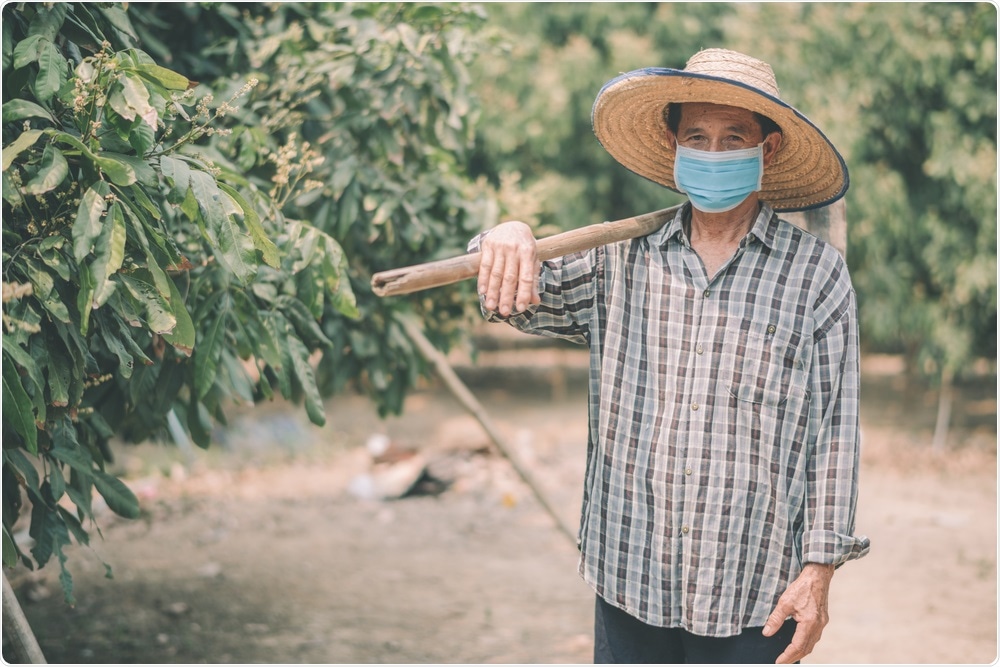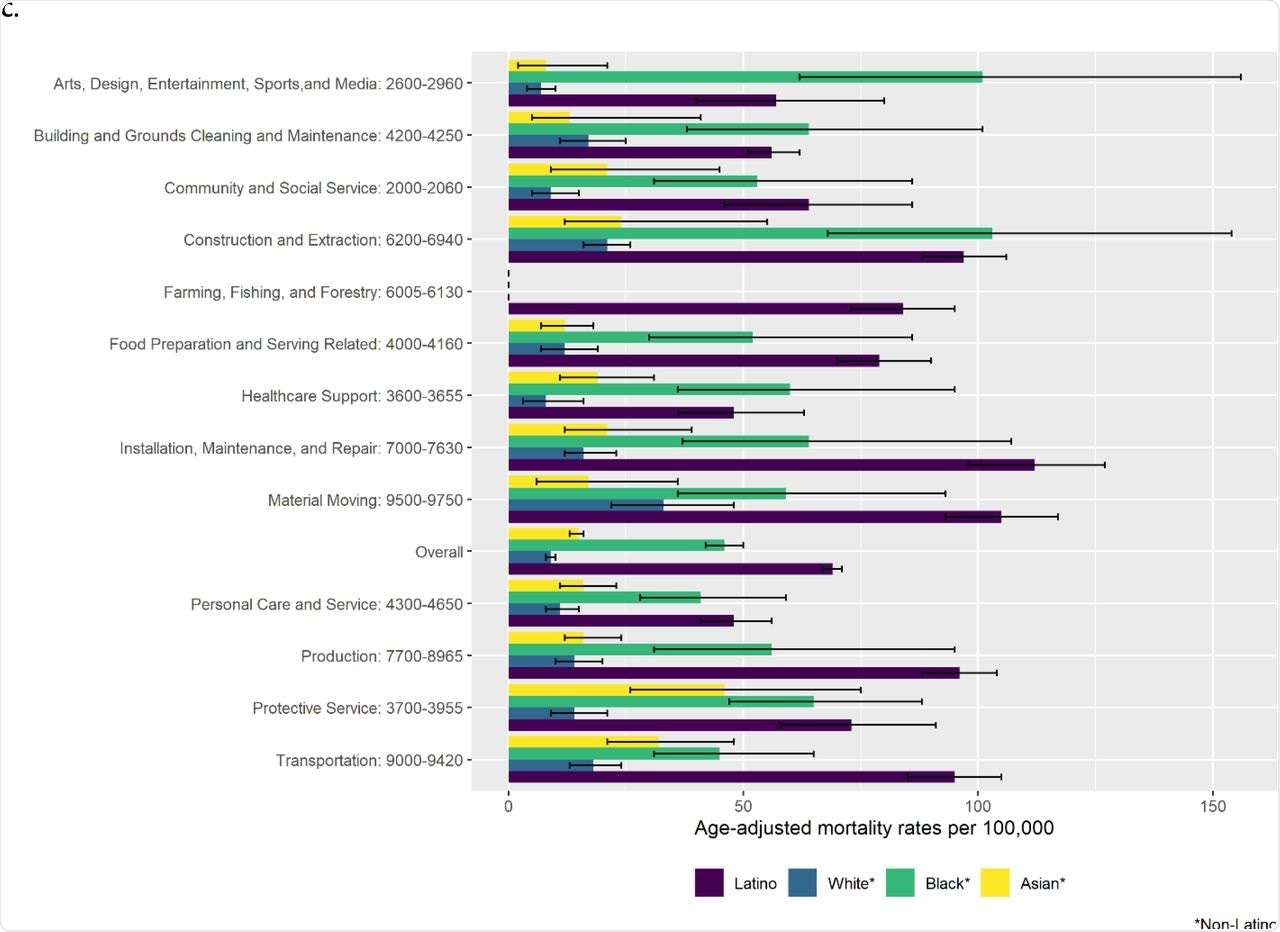A recent study published on the preprint server medRxiv* evaluates whether there is any correlation between the victims of coronavirus disease 2019 (COVID-19) and their occupation. To this end, the study found that in a California setting, individuals in manual labor and in-person service occupations experienced disproportionate COVID-19 mortality. This was found to be the highest rate observed among male, Latino, and Black workers.
 Study: Disparities in COVID-19 Fatalities among Working Californians. Image Credit: Apiwat Tumanil / Shutterstock.com
Study: Disparities in COVID-19 Fatalities among Working Californians. Image Credit: Apiwat Tumanil / Shutterstock.com

 This news article was a review of a preliminary scientific report that had not undergone peer-review at the time of publication. Since its initial publication, the scientific report has now been peer reviewed and accepted for publication in a Scientific Journal. Links to the preliminary and peer-reviewed reports are available in the Sources section at the bottom of this article. View Sources
This news article was a review of a preliminary scientific report that had not undergone peer-review at the time of publication. Since its initial publication, the scientific report has now been peer reviewed and accepted for publication in a Scientific Journal. Links to the preliminary and peer-reviewed reports are available in the Sources section at the bottom of this article. View Sources
Background
The ongoing COVID-19 pandemic, caused by severe acute respiratory syndrome coronavirus 2 (SARS-CoV-2), has imposed varying degrees of national lockdowns across the globe to mitigate the viral spread and infection. Despite continued efforts, to date, SARS-CoV-2 has infected over 252 million people and caused over 5.1 million deaths worldwide.
While restrictions were imposed to control the spread of SARS-CoV-2, many critical infrastructures continued to function to provide the basic needs for people. This raises the important question: is there a differential impact of COVID-19 on the working individual?
Any information on the occupational distribution of individuals who succumbed to COVID-19 is limited. The present study attempts to characterize COVID-19 fatalities among working individuals in California.
Once the community transmission of SARS-CoV-2 was identified, California issued a state-at-home order on March 19, 2020. However, critical sectors such as health, emergency services, food and agriculture, and transportation and logistics functioned where workers could work outside of the home.
Thus, it is reported that at least 4.7 million Californians, or 25% of the entire workforce, worked in person through the lockdown period. As a result, this population accounted for the reports 75% of confirmed COVID-19 cases and 29% of confirmed COVID-19 deaths in California as of November 2021.
Yet, the occupational distribution of COVID-19 mortality and morbidity rates in California is unknown. COVID-19 deaths may be differentially related to specific occupational sectors.
To understand the dynamics in this context and inform preventive interventions, the researchers undertook the present study to assess COVID-19 fatalities in 2020 among working Californians, describe the distribution of their occupations, and examine any temporal trends.
Study findings
COVID-19 related deaths counted for 9.9% of total fatalities among Californians between the ages 18-64 years. Of these, 2,486 fatalities could be matched to state employment records and thus were classified as “confirmed working.”
The researchers confirmed their working status at the time of infection by checking the Employment Development Department (EDD) records. The researchers did not include them under this status if the decedent was unemployed, retired, incarcerated, not paid, a student, or a homemaker. Of the remaining fatalities, the researchers classified them as “likely working” (n=4,121) or “not working” (n=1,443) based on the death certificate and case registry data.
For detailed information of the decedent, the researchers used the U.S. Census Bureau’s 2019 American Community Survey (ACS) Public Use Microdata Sample files for California. They aggregated the deaths at the occupational group level: 1) overall, 2) by sex, and 3) by race/ethnicity to calculate age-adjusted rates.
This study found that the “confirmed” and “likely working” COVID-19 decedents were predominantly male, Latino, and foreign-born, with high school or less education, as well as Black workers.
Furthermore, COVID-19 accounted for 10% of all deaths among working-age Californians in 2020. While these fatalities were unevenly distributed across the state’s population, the nine occupational groups which had higher mortality rates included those in farming, material moving, construction, production, food service, installation, cleaning, and transportation occupations.


 Age-adjusted COVID-19 Mortality Rates among Workers Ages 18-64 Years, California, 2020. (A) Overall and for all occupational groups. (B) Overall and for select occupational groups, by sex. (C) Overall and for select occupational groups, by race/ethnicity. Information on occupations included within each occupational group is available from the U.S. Census Bureau (https://www.bls.gov/cps/cenocc2010.htm).
Age-adjusted COVID-19 Mortality Rates among Workers Ages 18-64 Years, California, 2020. (A) Overall and for all occupational groups. (B) Overall and for select occupational groups, by sex. (C) Overall and for select occupational groups, by race/ethnicity. Information on occupations included within each occupational group is available from the U.S. Census Bureau (https://www.bls.gov/cps/cenocc2010.htm).
Interestingly, while COVID-19 deaths identified among working decedents in this study may have resulted from the transmission of infection in the workplace, at home, or elsewhere in the community, the researchers pointed that the occupations with the highest mortality in California overlapped with the critical infrastructure sectors that were exempt from the state’s stay-at-home order.
Thus, these high-mortality occupations may have been places of opportunity for viral exposure. This is supported by the several observed workplace outbreaks.
A major limitation of this study is that the researchers excluded COVID-19 decedents in California who did not undergo PCR testing, as a COVID-19 fatality is defined by death caused by COVID-19 that is confirmed by a positive polymerase chain reaction (PCR) test for SARS-CoV-2. This potentially underestimates the occupational burden of COVID-19 deaths accounted for in this study.
Conclusions
The current study showed that COVID-19 fatalities among working Californians included work-related cases. The highest rates were observed among male, Latino, and Black workers. Thus, the researchers recommended that occupations with elevated COVID-19 mortality rates should be prioritized by public health and regulatory authorities to ensure that non-pharmaceutical interventions are strictly implemented at workplaces.
Broadly, future pandemic responses must consider the concentration of historically disadvantaged racial/ethnic minorities, including undocumented immigrants, in high mortality occupations.

 This news article was a review of a preliminary scientific report that had not undergone peer-review at the time of publication. Since its initial publication, the scientific report has now been peer reviewed and accepted for publication in a Scientific Journal. Links to the preliminary and peer-reviewed reports are available in the Sources section at the bottom of this article. View Sources
This news article was a review of a preliminary scientific report that had not undergone peer-review at the time of publication. Since its initial publication, the scientific report has now been peer reviewed and accepted for publication in a Scientific Journal. Links to the preliminary and peer-reviewed reports are available in the Sources section at the bottom of this article. View Sources
Journal references:
- Preliminary scientific report.
Cummings, K. J., Beckman, J., Frederick, M., et al. (2021) Disparities in COVID-19 Fatalities among Working Californians. medRxiv. doi:10.1101/2021.11.10.21266195. https://www.medrxiv.org/content/10.1101/2021.11.10.21266195v1.
- Peer reviewed and published scientific report.
Cummings, Kristin J., John Beckman, Matthew Frederick, Robert Harrison, Alyssa Nguyen, Robert Snyder, Elena Chan, et al. 2022. “Disparities in COVID-19 Fatalities among Working Californians.” Edited by Khin Thet Wai. PLOS ONE 17 (3): e0266058. https://doi.org/10.1371/journal.pone.0266058.
- Peer reviewed and published scientific report.
. https://journals.plos.org/plosone/article?id=10.1371/journal.pone.0266058
Article Revisions
- Jun 10 2023 - The preprint preliminary research paper that this article was based upon was accepted for publication in a peer-reviewed Scientific Journal. This article was edited accordingly to include a link to the final peer-reviewed paper, now shown in the sources section.